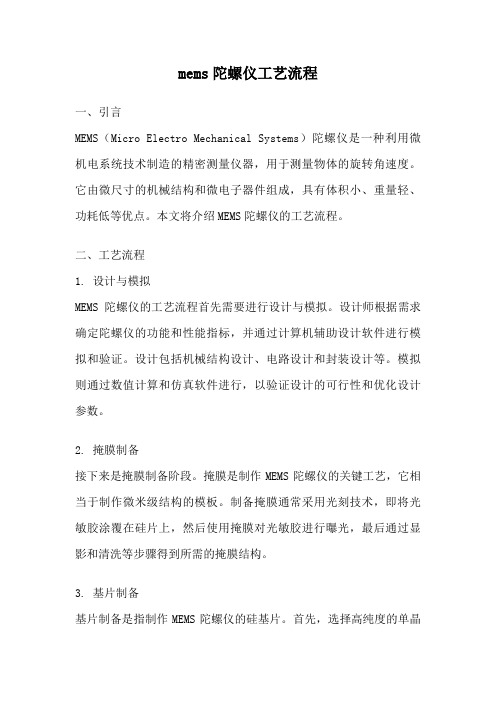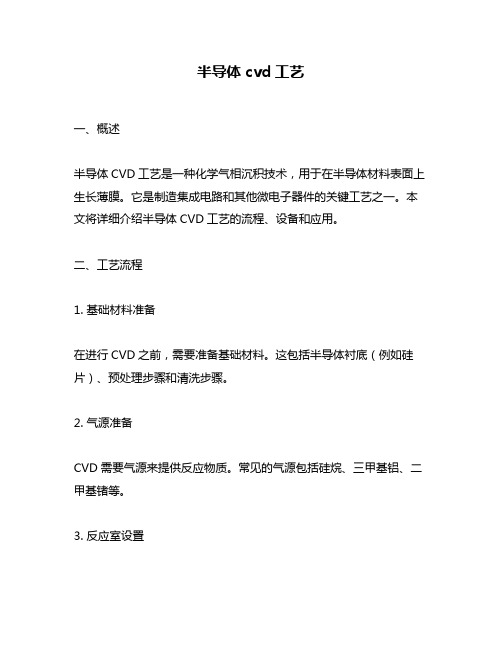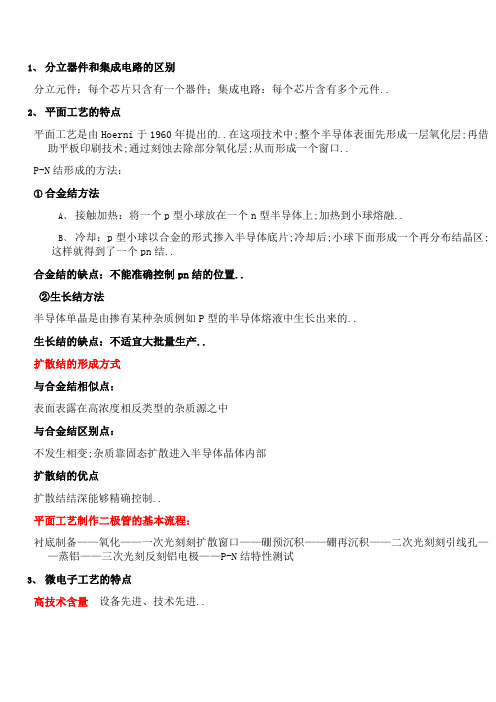微电子工艺的主要流程
mems陀螺仪工艺流程

mems陀螺仪工艺流程一、引言MEMS(Micro Electro Mechanical Systems)陀螺仪是一种利用微机电系统技术制造的精密测量仪器,用于测量物体的旋转角速度。
它由微尺寸的机械结构和微电子器件组成,具有体积小、重量轻、功耗低等优点。
本文将介绍MEMS陀螺仪的工艺流程。
二、工艺流程1. 设计与模拟MEMS陀螺仪的工艺流程首先需要进行设计与模拟。
设计师根据需求确定陀螺仪的功能和性能指标,并通过计算机辅助设计软件进行模拟和验证。
设计包括机械结构设计、电路设计和封装设计等。
模拟则通过数值计算和仿真软件进行,以验证设计的可行性和优化设计参数。
2. 掩膜制备接下来是掩膜制备阶段。
掩膜是制作MEMS陀螺仪的关键工艺,它相当于制作微米级结构的模板。
制备掩膜通常采用光刻技术,即将光敏胶涂覆在硅片上,然后使用掩膜对光敏胶进行曝光,最后通过显影和清洗等步骤得到所需的掩膜结构。
3. 基片制备基片制备是指制作MEMS陀螺仪的硅基片。
首先,选择高纯度的单晶硅材料,并进行切割和研磨,以获得平整的硅片。
然后,在硅片上进行氧化处理,形成氧化硅层,作为陀螺仪的基底。
接下来,通过光刻、蚀刻和沉积等工艺步骤,在硅片上制备出陀螺仪的机械结构和电路等。
4. 结构制备结构制备是制作MEMS陀螺仪的关键步骤之一。
通过光刻和蚀刻等工艺,在硅片上制备出陀螺仪的机械结构,包括感应电极、驱动电极和挠曲结构等。
其中,感应电极用于检测陀螺仪的旋转角速度,驱动电极用于施加驱动力,挠曲结构则用于实现陀螺仪的旋转测量。
5. 封装与封装测试在结构制备完成后,需要对MEMS陀螺仪进行封装。
封装工艺通常包括焊接、封装材料注入、密封和测试等步骤。
焊接是将陀螺仪芯片与封装底座焊接在一起,以提供电气连接。
封装材料注入是将封装材料注入封装底座中,以保护陀螺仪芯片。
密封是将封装底座密封,以防止外界环境对陀螺仪的影响。
封装测试是对封装后的陀螺仪进行性能测试,以确保其符合设计要求。
微电子工艺流程(PDF 44页)

20、电极多晶硅的淀积
• 利用低压化学气相沉积(LPCVD ) 技 术在晶圆表面沉积多晶硅,以做为连接 导线的电极。
华中科技大学电子科学与技术系
21、电极掩膜的形成
• 涂布光刻胶在晶圆上,再利用光刻技术 将电极的区域定义出来。
华中科技大学电子科学与技术系
22、活性离子刻蚀
晶格排列。退火就是利
用热能来消除晶圆中晶
格缺陷和内应力,以恢
复晶格的完整性。同时
使注入的掺杂原子扩散
到硅原子的替代位置,
使掺杂元素产生电特
性。
华中科技大学电子科学与技术系
11、去除二氧化硅
• 利用湿法刻蚀方法去除晶圆表面的二氧化 硅。
华中科技大学电子科学与技术系
12、前置氧化
• 利用热氧化法在晶圆上形成一层薄的氧 化层,以减轻后续氮化硅沉积工艺所产 生的应力。
• 利用活性离子刻蚀技术刻蚀出多晶硅电 极结构,再将表面的光刻胶去除。
华中科技大学电子科学与技术系
23、热氧化
• 利用氧化技术,在晶圆表面形成一层氧 化层。
华中科技大学电子科学与技术系
24、NMOS源极和漏极形成
• 涂布光刻胶后,利用光刻技术形成NMOS源极与漏极 区域的屏蔽,再利用离子注入技术将砷元素注入源极 与漏极区域,而后将晶圆表面的光刻胶去除。
1. 洁净室和清洗 2. 氧化和化学气相淀积 3. 光刻和腐蚀 4. 扩散和离子注入 5. 金属连接和平面化 三. 标准CMOS工艺流程
华中科技大学电子科学与技术系
1、初始清洗
• 初始清洗就是将晶圆放入清洗槽中,利用化学或物理的 方法将在晶圆表面的尘粒或杂质去除,防止这些杂初始 清洗就是将晶圆放入清洗槽中,利用化学或物理的方法 将在晶圆表面的尘粒或杂质去除,防止这些杂质尘 粒, 对后续的工艺造成影响,使得器件无法正常工作。
半导体cvd工艺

半导体cvd工艺一、概述半导体CVD工艺是一种化学气相沉积技术,用于在半导体材料表面上生长薄膜。
它是制造集成电路和其他微电子器件的关键工艺之一。
本文将详细介绍半导体CVD工艺的流程、设备和应用。
二、工艺流程1. 基础材料准备在进行CVD之前,需要准备基础材料。
这包括半导体衬底(例如硅片)、预处理步骤和清洗步骤。
2. 气源准备CVD需要气源来提供反应物质。
常见的气源包括硅烷、三甲基铝、二甲基锗等。
3. 反应室设置反应室是进行CVD反应的地方。
它通常由高温炉子和反应器组成。
在进行CVD反应之前,需要将反应器清洗干净,并将所需的气源送入反应室中。
4. 气态淀积层生长一旦所有材料和设备都准备就绪,就可以开始进行气态淀积层生长了。
在此过程中,所需的气源会被引入到高温反应室中,然后在半导体衬底表面上沉积一层薄膜。
5. 氧化在CVD过程结束后,需要进行氧化处理。
这通常包括将样品放入氧化炉中,在高温和高压下进行氧化反应。
这个步骤可以增强薄膜的质量和稳定性。
6. 后处理最后,需要进行后处理步骤,以确保薄膜的完整性和可靠性。
这可能包括清洗、退火或其他处理方法。
三、设备1. 反应器反应器是CVD工艺的核心部件。
它是一个密封的容器,用于将气源送入其中,并在高温下使其反应并沉积到半导体衬底上。
2. 气源系统气源系统用于将所需的气源输送到反应器中。
它通常由几个瓶子、阀门、流量计和管道组成。
3. 炉子炉子是用于加热反应器的设备。
它可以通过控制温度来控制CVD过程中的反应速率和沉积速率。
4. 气相分析仪气相分析仪用于监测CVD过程中产生的气体。
它可以帮助确定反应条件是否正确,并且可以检测到任何意外的气体泄漏。
5. 氧化炉氧化炉用于进行氧化处理,以增强薄膜的质量和稳定性。
它通常由一个密封的炉子和一个高温和高压的环境组成。
四、应用1. 集成电路制造CVD工艺是制造集成电路中各种元件所需的关键步骤之一。
它可以用于生长多种材料,包括二氧化硅、多晶硅、金属等。
微组装技术简述及工艺流程及设备

2.优点——MCM技术有以下主要优点。
1)使电路组装更加高密度化,进一步实现整机 的小型化和轻量化。与同样功能的SMT组装 电路相比,通常MCM的重量可减轻 80%~90%,其尺寸减小70~80%。在军事应 用领域,MCM的小型化和轻量化效果更为明 显,采用MCM技术可使导弹体积缩小90%以 上,重量可减轻80%以上。卫星微波通信系 统中采用MCM技术制作的T/R组件,其体积 仅为原来的1/10~1/20。
3)淀积型MCM(MCM-D,其中D是“淀积”的英 文名Deposition 的第一个字母),系采用高密度 薄膜多层布线基板构成的多芯片组件。其主要特 点是布线密度和组装效率高,具有良好的传输特 性、频率特性和稳定性.
4)混合型MCM-H(MCM-C/D和MCM-L/D,其中 英文字母C、D、L的含义与上述相同),系采用 高密度混合型多层基板构成的多芯片组件。这是 一种高级类型的多芯片组件,具有最佳的性能/价 格比、组装密度高、噪声和布线延迟均比其它类 型MCM小等特点。这是由于混合多层基板结合了 不同的多层基板工艺技术,发挥了各自长处的缘 故。特别适用于巨型、高速计算机系统、高速数 字通信系统、高速信号处理系统以及笔记本型计 算机子系统。
2)厚膜陶瓷型MCM(MCM-C,其中C是“陶瓷 ”的英文名Ceramic的第一个字母),系采用 高密度厚膜多层布线基板或高密度共烧陶瓷 多层基板构成的多芯片组件。其主要特点是 布线密度较高,制造成本适中,能耐受较恶 劣的使用环境,其可靠性较高,特别是采用 低温共烧陶瓷多层基板构成的MCM-C,还 易于在多层基板中埋置元器件,进一步缩小 体积,构成多功能微电子组件。MCM-C主 要应用于30~50MHz的高可靠中高档产品。 包括汽车电子及中高档计算机和数字通信领 域。
微电子09集成电路制造工艺

集成电路制造技术的发展推动了电子技术的进步, 促进了信息产业的发展。
集成电路制造的流程
材料准备
选择合适的衬底材料,并进行清 洗和加工。
图形制备
将电路设计转换为实际的生产图 形,并进行光刻和刻蚀。
薄膜制备
在衬底上沉积所需的薄膜材料, 如金属、介质等。
互连
将电路元件和互连线连接起来, 形成完整的电路系统。
集成电路制造是将电子元器件和电路设计转变为实际可用的集成 电路的过程,包括材料准备、图形制备、薄膜制备、掺杂、刻蚀 、互连等多个环节。
集成电路制造的重要性
提高性能
集成电路制造技术能够将更多的电子元器件集成到 更小的空间内,从而提高电子产品的性能。
降低成本
集成电路制造技术能够实现大规模生产,降低单个 元器件的成本,从而降低整个电子产品的成本。
80%
导体材料
如金、银、铜等,用于制造集成 电路中的导线和连接器。
微电子设备
刻蚀设备
用于在半导体材料上刻蚀出电 路和元件的轮廓。
镀膜设备
用于在半导体材料上沉积金属 或化合物,形成电路和元件的 导线和介质层。
检测设备
用于检测集成电路的质量和性 能,如电子显微镜、X射线检 测仪等。
微电子材料与设备的发展趋势
新材料的研发和应用
随着集成电路技术的发展,对材料的 要求越来越高,需要不断研发新的材 料来满足集成电路的性能和可靠性要 求。
高精度设备的研发和应用
智能制造技术的应用
将人工智能、大数据等技术与微电子 制造相结合,实现智能化制造,提高 生产效率和产品质量。
为了制造更小、更复杂的集成电路, 需要研发更高精度的设备来提高制造 效率和产品质量。
微电子封装技术第2章 封装工艺流程

2.4芯片贴装
焊接粘贴法工艺是将芯片背面淀积一定厚度的 Au或Ni,同时在焊盘上淀积Au-Pd-Ag和Cu的金属 层。
其优点是热传导好。工艺是将芯片背面淀积一 定厚度的Au或Ni,同时在焊盘上淀积Au-Pd-Ag和 Cu的金属层。这样就可以使用Pb-Sn合金制作的合 金焊料将芯片焊接在焊盘上。焊接温度取决于PbSn合金的具体成分比例。
微电子封装技术
董海青 李荣茂
第2章 封装工艺流程
2.1 流程概述 2.2 芯片减薄 2.3 芯片切割 2.4 芯片贴装 2.5 芯片互连技术 2.6 成形技术 2.7 后续工艺
2.1 流程概述
芯片封装工艺流程一般可以分为两个部分:前 段操作和后段操作。前段操作一般是指用塑料封装 (固封)之前的工艺步骤,后段操作是指成形之后 的工艺步骤。
2.4芯片贴装
导电胶粘贴法不要求芯片背面和基板具有金属 化层,芯片座粘贴后,用导电胶固化要求的温度时 间进行固化,可以在洁净的烘箱中完成固化,操作 起来比较简便易行。
导电胶进行芯片贴装的工艺过程如下:用针筒 或注射器将黏着剂涂布在芯片焊盘上,然后将芯片 精确地放置到焊盘的黏着剂上面。
导电胶粘贴法的缺点是热稳定性不好,容易在 高温时发生劣化及引发黏着剂中有机物气体成分泄 露而降低产品的可靠度,因此不适用于高可靠度要 求的封装。
2.4芯片贴装
玻璃胶粘贴芯片时,先以盖印、网印、点胶等 技术将玻璃胶原料涂布在基板的芯片座上,将IC芯 片放置在玻璃胶上后,再将封装基板加热至玻璃熔 融温度以上即可完成粘贴。
玻璃胶粘贴法的优点是可以得到无空隙、热稳 定性优良、低结合应力与低湿气含量的芯片粘贴; 其缺点是玻璃胶中的有机成分与溶剂必须在热处理 时完全去除,否则对封装结构及其可靠度将有所损 害。
微电子工艺

微电子工艺引论ﻫ硅片、芯片的概念硅片:制造电子器件的基本半导体材料硅的圆形单晶薄片ﻫ芯片:由硅片生产的半导体产品*什么是微电子工艺技术?微电子工艺技术主要包括哪些技术?微电子工艺技术:在半导体材料芯片上采用微米级加工工艺制造微小型化电子元器件和微型化电路技术主要包括:超精细加工技术、薄膜生长和控制技术、高密度组装技术、过程检测和过程控制技术等集成电路制造涉及的五个大的制造阶段的内容硅片制备:将硅从沙中提炼并纯化、经过特殊工艺产生适当直径的硅锭、将硅锭切割成用于制造芯片的薄硅片ﻫ芯片制造:硅片经过各种清洗、成膜、光刻、刻蚀和掺杂步骤,一整套集成电路永久刻蚀在硅片上ﻫ芯片测试/拣选:对单个芯片进行探测和电学测试,挑选出可接受和不可接受的芯片、为有缺陷的芯片做标记、通过测试的芯片将继续进行以后的步骤装配与封装:对硅片背面进行研磨以减少衬底的厚度、将一片厚的塑料膜贴在硅片背面、在正面沿着划片线用带金刚石尖的锯刃将硅片上的芯片分开、在装配厂,好的芯片被压焊或抽空形成装配包、将芯片密封在塑料或陶瓷壳内ﻫ终测:为确保芯片的功能,对每一个被封装的集成电路进行电学和环境特性参数的测试IC工艺前工序、IC工艺后工序、以及IC工艺辅助工序IC工艺前工序:(1)薄膜制备技术:主要包括外延、氧化、化学气相淀积、物理气相淀积(如溅射、蒸发) 等(2)掺杂技术:主要包括扩散和离子注入等技术ﻫ(3)图形转换技术:主要包括光刻、刻蚀等技术ﻫIC工艺后工序:划片、封装、测试、老化、筛选IC工艺辅助工序:超净厂房技术超纯水、高纯气体制备技术ﻫ光刻掩膜版制备技术材料准备技术ﻫ微芯片技术发展的主要趋势ﻫ提高芯片性能(速度、功耗)、提高芯片可靠性(低失效)、降低芯片成本(减小特征尺寸,增加硅片面积,制造规模)什么是关键尺寸(CD)?芯片上的物理尺寸特征称为特征尺寸,特别是硅片上的最小特征尺寸,也称为关键尺寸或CD半导体材料ﻫ本征半导体和非本征半导体的区别是什么?本征半导体:不含任何杂质的纯净半导体,其纯度在99.999999%(8~10个9)ﻫ为何硅被选为最主要的半导体材料?ﻫa)硅的丰裕度——制造成本低b) 熔点高(1412 OC)——更宽的工艺限度和工作温度范围c) SiO2的天然生成GaAs相对Si的优点和缺点是什么?ﻫ优点:a) 比硅更高的电子迁移率,高频微波信号响应好——无线和高速数字通信b) 抗辐射能力强——军事和空间应用ﻫc) 电阻率大——器件隔离容易实现主要缺点:a) 没有稳定的起钝化保护作用的自然氧化层ﻫb) 晶体缺陷比硅高几个数量级ﻫc) 成本高圆片的制备ﻫ两种基本的单晶硅生长方法。
微组装技术简述及工艺流程及设备教材

NASA采用厚膜混合集成技术研制了导弹制导计算机 的运算组件。其中采用了2.88in见方的厚膜多层布线基板, 组装了5个大规模半导体集成电路芯片,12个中规模半导 体集成电路芯片(TTL),6个片式电容和6个片式电阻, 629根键合互连丝。 采用厚膜集成技术制作厚膜混合集成DC∕DC变换器是 厚膜混合电路的一大类产品。其产品功率范围达1W~120 W,电流最大20A ,输出路数从单路到三路,开关频率 300kHz~550kHz,国内120W DC∕DC变换器产品的功率密 度达78W∕in3,输出电压15V ,输出电流8A,效率85 % , 纹波<100 mV 。电性能与INTERPOINT同类产品相同, 功率密度高于INTERPOINT同类产品(后者为66.3 W∕in3)。 还可制作高压输出(160V~900V)的厚膜混合集成 DC∕DC变换器.
3.类型和特点——
通常可按 MCM 所用高密度多层布线基板的结构 和工艺,将MCM分为以下几个类型。 1)叠层型MCM(MCM-L,其中L为“叠层”的 英文词“Laminate”的第一个字母)也称为L 型多芯片组件,系采用高密度多层印制电路板 构成的多芯片组件,其特点是生产成本低,制 造工艺较为成熟,但布线密度不够高,其组装 效率和性能较低,主要应用于30MHz和100个 焊点/英寸2以下的产品以及应用环境不太严酷 的消费类电子产品和个人计算机等民用领域。
八。薄膜混合电路定义及其应用特点
1.定义——采用物理汽相淀积(PVD,蒸发、溅射
和离子镀等)或化学汽相淀积(CVD)工艺 以及湿刻(光刻)或干刻(等离子刻蚀等)
图形形成技术,在基板上形成薄膜元件和布
线,然后组装微型元器件(多为芯片和片式 元器件)构成具有一定功能的微电路。 区分是“薄膜”还是“厚膜”,主要按工艺技术分,而 非主要按其膜厚度(虽然厚度有区别,GJB548中提到, 薄膜厚度通常小于5微米)
MEMS的主要工艺类型与流程

MEMS的主要工艺类型与流程(LIGA技术简介)目录〇、引言一、什么是MEMS技术1、MEMS的定义2、MEMS研究的历史3、MEMS技术的研究现状二、MEMS技术的主要工艺与流程1、体加工工艺2、硅表面微机械加工技术3、结合技术4、逐次加工三、LIGA技术、准LIGA技术、SLIGA技术1、LIGA技术是微细加工的一种新方法,它的典型工艺流程如上图所示。
2、与传统微细加工方法比,用LIGA技术进行超微细加工有如下特点:3、LIGA技术的应用与发展4、准LIGA技术5、多层光刻胶工艺在准LIGA工艺中的应用6、SLIGA技术四、MEMS技术的最新应用介绍五、参考文献六、课程心得〇、引言一、什么是MEMS技术1、MEMS的概念MEMS即Micro-Electro-MechanicalSytem,它是以微电子、微机械及材料科学为基础,研究、设计、制造、具有特定功能的微型装置,包括微结构器件、微传感器、微执行器和微系统等。
一般认为,微电子机械系统通常指的是特征尺度大于1μm小于1nm,结合了电子和机械部件并用IC集成工艺加工的装置。
微机电系统是多种学科交叉融合具有战略意义的前沿高技术,是未来的主导产业之一。
MEMS技术自八十年代末开始受到世界各国的广泛重视,主要技术途径有三种,一是以美国为代表的以集成电路加工技术为基础的硅基微加工技术;二是以德国为代表发展起来的利用某射线深度光刻、微电铸、微铸塑的LIGA(Lithographgalvanfomungundabformug)技术,;三是以日本为代表发展的精密加工技术,如微细电火花EDM、超声波加工。
MEMS技术特点是:小尺寸、多样化、微电子等。
(1)微型化:MEMS体积小(芯片的特征尺寸为纳米/微米级)、质量轻、功耗低、惯性小、谐振频率高、响应时间短。
例如,一个压力成像器的微系统,含有1024个微型压力传感器,整个膜片尺寸仅为10mm某10mm,每个压力芯片尺寸为50μm某50μm。
微电子工艺基本流程

微电子工艺基本流程英文回答:The basic process flow of microelectronic fabrication involves several key steps. These steps are essential in creating integrated circuits and other microelectronic devices. Let's take a look at the basic process flow:1. Substrate Preparation: The first step in the process is to prepare the substrate. This typically involves cleaning and polishing the substrate material, such as silicon or gallium arsenide, to remove any impurities and create a smooth surface.2. Deposition: Once the substrate is prepared, various thin films are deposited onto the surface. This can be done through techniques such as physical vapor deposition (PVD) or chemical vapor deposition (CVD). The purpose of deposition is to create layers of materials with specific properties, such as conductive or insulating layers.3. Lithography: After deposition, a layer ofphotoresist is applied to the surface. The photoresist is then exposed to a pattern of light, using a mask, which causes a chemical change in the resist. This patterntransfer step is crucial for defining the desired circuit pattern onto the substrate.4. Etching: The exposed areas of the resist are removed, leaving behind a patterned resist layer. The substrate is then subjected to an etching process, which selectively removes the exposed areas of the thin films. This step is used to create features, such as trenches or vias, in the thin film layers.5. Doping: In order to create regions of different electrical properties, the substrate may undergo a doping process. This involves introducing impurities, such asboron or phosphorus, into specific areas of the substrate. Doping is crucial for creating regions with different conductivity, such as p-type or n-type regions.6. Metallization: Once the desired features andelectrical properties are achieved, a layer of metal is deposited onto the substrate. This metal layer is used to interconnect different components of the circuit andprovide electrical contact.7. Packaging: The final step in the process is the packaging of the microelectronic device. This involves encapsulating the device in a protective material, such as plastic or ceramic, and connecting it to external leads or connectors.中文回答:微电子制造的基本流程包括几个关键步骤。
微电子加工工艺总结

1、分立器件和集成电路的区别分立元件:每个芯片只含有一个器件;集成电路:每个芯片含有多个元件..2、平面工艺的特点平面工艺是由Hoerni于1960年提出的..在这项技术中;整个半导体表面先形成一层氧化层;再借助平板印刷技术;通过刻蚀去除部分氧化层;从而形成一个窗口..P-N结形成的方法:①合金结方法A、接触加热:将一个p型小球放在一个n型半导体上;加热到小球熔融..B、冷却:p型小球以合金的形式掺入半导体底片;冷却后;小球下面形成一个再分布结晶区;这样就得到了一个pn结..合金结的缺点:不能准确控制pn结的位置..②生长结方法半导体单晶是由掺有某种杂质例如P型的半导体熔液中生长出来的..生长结的缺点:不适宜大批量生产..扩散结的形成方式与合金结相似点:表面表露在高浓度相反类型的杂质源之中与合金结区别点:不发生相变;杂质靠固态扩散进入半导体晶体内部扩散结的优点扩散结结深能够精确控制..平面工艺制作二极管的基本流程:衬底制备——氧化——一次光刻刻扩散窗口——硼预沉积——硼再沉积——二次光刻刻引线孔——蒸铝——三次光刻反刻铝电极——P-N结特性测试3、微电子工艺的特点高技术含量设备先进、技术先进..高精度光刻图形的最小线条尺寸在亚微米量级;制备的介质薄膜厚度也在纳米量级;而精度更在上述尺度之上..超纯指工艺材料方面;如衬底材料Si、Ge单晶纯度达11个9..超净环境、操作者、工艺三个方面的超净;如 VLSI在100级超净室10级超净台中制作..大批量、低成本图形转移技术使之得以实现..高温多数关键工艺是在高温下实现; 如:热氧化、扩散、退火 ..4、芯片制造的四个阶段固态器件的制造分为4个大的阶段粗线条:①材料制备②晶体生长/晶圆准备③晶圆制造、芯片生成④封装晶圆制备:1获取多晶2晶体生长----制备出单晶;包含可以掺杂元素掺杂和母金掺杂3硅片制备----制备出空白硅片硅片制备工艺流程从晶棒到空白硅片:晶体准备直径滚磨、晶体定向、导电类型检查和电阻率检查→切片→研磨→化学机械抛光CMP→背处理→双面抛光→边缘倒角→抛光→检验→氧化或外延工艺→打包封装芯片制造的基础工艺增层——光刻——掺杂——热处理5、high-k技术High—K技术是在集成电路上使用高介电常数材料的技术;主要用于降低金属化物半导体MOS晶体管栅极泄漏电流的问题..集成电路技术的发展是伴随着电路的元器件如MOS晶体管结构尺寸持续缩小实现的..随着MOS晶体管结构尺寸的缩小;为了保持棚极对MOS晶体管沟道电流的调控能力;需要在尺寸缩小的同时维持栅极电容的容量;这通常需要通过减小棚极和沟道之间的绝缘介质层厚度来实现;但由此引起的棚极和沟道之间的漏电流问题越来越突出..High—K技术便是解决这一问题的优选技术方案..因为;MOS器件栅极电容类似于一个平板电容;由于MOS器件面积、绝缘介质层厚度和介电常数共同决定;因此MOS器件栅极电容在器件面积减小的前提下;采用了High—K材料后;可以在不减小介质层厚度因此栅极泄漏电流而不增加的前提下;实现维护栅极电容容量不减小的目标.. High—K材料技术已被英特尔和IBM应用到其新开发的45mm 量产技术中..目前业界常用的High—K材料主要是包括HfO在内的Hf基介质材料..26、拉单晶的过程装料——融化——种晶——引晶——放肩——等径——收尾——完成7、外延技术的特点和应用外延特点:生成的晶体结构良好掺入的杂质浓度易控制可形成接近突变pn结的特点外延分类:按工艺分类A 气相外延VPE利用硅的气态化合物或者液态化合物的蒸汽;在加热的硅衬底表面和氢发生反应或自身发生分解还原出硅..B 液相外延LPE衬底在液相中;液相中析出的物质并以单晶形式淀积在衬底表面的过程..此法广泛应用于III-V族化合半导体的生长..原因是化合物在高温下易分解;液相外延可以在较低的温度下完成..C 固相外延SPED 分子束外延MBE在超高真空条件下;利用薄膜组分元素受热蒸发所形成的原子或分子束;以很高的速度直接射到衬底表面;并在其上形成外延层的技术..特点:生长时衬底温度低;外延膜的组分、掺杂浓度以及分布可以实现原子级的精确控制..按导电类型分类n型外延:n/n; n/p外延 p型外延:p/n; p/p外延按材料异同分类同质外延:外延层和衬底为同种材料;例如硅上外延硅..异质外延:外延层和衬底为不同种材料;例如SOI绝缘体上硅是一种特殊的硅片;其结构的主要特点是在有源层和衬底层之间插入绝缘层———埋氧层来隔断有源层和衬底之间的电气连接按电阻率高低分类正外延:低阻衬底上外延高阻层n/n+反外延:高阻衬底上外延低阻层硅的气相外延的原理:在气相外延生长过程中;有两步:质量输运过程--反应剂输运到衬底表面表面反应过程--在衬底表面发生化学反应释放出硅原子掺杂有意掺杂:按器件对外延导电性和电阻率的要求;在外延的同时掺入适量的杂质;这称为有意掺杂..自掺杂:衬底中的杂质因挥发等而进入气流;然后重新返回外延层..杂质外扩散:重掺杂衬底中的杂质通过热扩散进入外延层..外延的应用1、双极型电路:n/n+外延;在n型外延层上制作高频功率晶体管..n/p外延:双极型传统工艺在p衬底上进行n型外延通过简单的p型杂质隔离扩散;实现双极型集成电路元器件的隔离..2、MOS电路:外延膜的主要应用是作为双极型晶体管的集电极..外延膜在MOS集成电路中的较新应用是利用重掺杂外延减小闩锁效应寄生闸流管效应..8、分子束外延MBE的原理及其应用在超高真空下;热分子束由喷射炉喷出;射到衬底表面;外延生长出外延层..9、二氧化硅膜的用途表面钝化:保护器件的表面及内部;禁锢污染物..掺杂阻挡层:作为杂质扩散的掩蔽膜;杂质在二氧化硅中的运行速度低于在硅中的运行速度..绝缘介质:IC器件的隔离和多层布线的电隔离;MOSFET的栅电极;MOS电容的绝缘介质..10、二氧化硅膜的获得方法A:热氧化工艺B:化学气相淀积工艺C:溅射工艺D:阳极氧化工艺11、热氧化机制①线性阶段;②抛物线阶段生长逐渐变慢;直至不可忍受影响氧化速率的因素有:氧化剂、晶向、掺杂类型和浓度、氧化剂的分压..热氧化生长方法:1干氧氧化:干燥氧气;不能有水分;随着氧化层的增厚;氧气扩散时间延长;生长速率减慢;适合/Si界面与硅反应..较薄的氧化层的生长..氧化剂扩散到SiO22水汽氧化:气泡发生器或氢氧合成气源;原理:3湿氧氧化:湿氧氧化的各种性能都是介于干氧氧化和水汽氧化之间;其掩蔽能力和氧化质量都能够满足一般器件的要求..4掺氯氧化:薄的MOS栅极氧化要求非常洁净的膜层;如果在氧化中加入氯;器件的性能和洁净度都会得到改善..减弱二氧化硅中的移动离子主要是钠离子的沾污影响;固定Na+离子;减少硅表面及氧化层的结构缺陷/Si界面特性:12、SiO2/Si界面杂质发生再分热氧化薄膜是由硅表面生长得到的二氧化硅薄膜..高温生长工艺将使SiO2布;与二氧化硅接触的硅界面的电学特性也将发生变化..杂质再分布:有三个因素:①分凝效应② 扩散速率③ 界面移动/Si界面杂质的再分布就远小于干氧氧化;湿氧水汽氧化速率远大于干氧氧化速率;水汽氧化SiO2氧化速率介于水汽、干氧之间;SiO/Si界面杂质的再分布也介于水汽、干氧之间..2/Si界面P-Si的反型层;以二氧化硅层中存在着与制备工艺有关的正电荷;这种正电荷将引起SiO2及MOS器件阈值电压不稳定等现象..可动离子或可动电荷主要是Na+、K+、H+ 等;这些离子在二氧化硅中都是网络修正杂质;为快扩散杂质..其中主要是Na+..在人体与环境中大量存在Na+;热氧化时容易发生Na+沾污..加强工艺卫生方可以避免Na+沾污;也可采用掺氯氧化;固定Na+离子..固定离子或固定电荷主要是氧空位..一般认为:固定电荷与界面一个很薄的约30 过渡区有关;过渡区有过剩的硅离子;过剩的硅在氧化过程中与晶格脱开;但未与氧完全反应..干氧氧化空位最少;水汽氧化氧空位最多..热氧化时;首先采用干氧氧化方法可以减小这一现象..氧化后;高温惰性气体中退火也能降低固定电荷..13、氧化膜厚度的检测劈尖干涉和双光干涉:利用干涉条纹进行测量;因为要制造台阶;所以为破坏性测量..比色法:以一定角度观察SiO2膜;SiO2膜呈现干涉色彩;颜色与厚度存在相应关系..比色法方便迅速;但只是粗略估计..椭圆仪法:入射的椭圆偏振光经氧化膜的多次反射和折射以后;得到了改变椭圆率的反射椭圆偏振光;其改变量和膜厚与折射率相关..高频MOS结构C-V法:测量金属栅极的电容;利用公式测量氧化膜层的厚度..14、化学气相沉积定义化学气相淀积Chemical Vapor Deposition是通过气态物质的化学反应在衬底上淀积薄膜的工艺方法..与之对应的是:PVD蒸发和溅射;它主要应用于导体薄膜..15、淀积技术包括哪两种CVD和PVD16、LPCVD和APCVD的主要区别 LPCVD有何优势APCVD:原料以气相方式被输送到反应器内;原料气体向衬底基片表面扩散;被基片吸附;由于基片的温度高或其它能量提供给原料气体;使其发生表面化学反应;生成物在基片表面形成薄膜;而生成物中的其它物质是气相物质;扩散到气相中被带走..LPCVD:低压情况下;分子自由程较长;薄膜电极的均匀性较高..LPCVD相对APCVD的特点:增加了真空系统;气压在1-10-2Torr之间;压下分子自由程长;可以竖放基片;热系统一般是电阻热壁式..17、PECVD的机理 PECVD有何优势优势:采用等离子体把电能耦合到气体中;促进化学反应进行;由此淀积薄膜;因此该法可以在较低温度下淀积薄膜..PECVD常常是低温和低压的结合..机理:反应器的射频功率使低压气体真空度1-10Torr产生非平衡辉光放电;雪崩电离激发出的高能电子通过碰撞激活气体形成等离子体..衬底基片具有一定温度;约300℃吸附活泼的中性原子团与游离基即高能的等离子体发生化学反应;生成的薄膜物质被衬底吸附、重排进而形成淀积薄膜;衬底温度越高形成的薄膜质量越好..18、多晶硅淀积和外延淀积的主要区别..淀积多晶硅薄膜的方法:主要采用LPCVD的方法..掺杂则采用:离子注入;化学气相淀积;扩散..多晶硅的淀积和外延淀积的主要区别:硅烷的使用19、金属薄膜的用途金属化的作用1在微电子器件与电路中金属薄膜最重要的用途是作为内电极MOS栅极和电容器极板和各元件之间的电连接..2在某些存储电路中作为熔断丝..3 用于晶圆的背面通常是金;提高芯片和封装材料的黏合力..金属化的作用:集成电路中金属化的作用是将有源器件按设计的要求连接起来;形成一个完整的电路与系统..20、说明为什么铝作为通常使用的金属薄膜; 说明铜作为新一代金属薄膜的原因..铝膜:用途: 大多数微电子器件或集成电路是采用铝膜做金属化材料优点:导电性较好;与p-Si;n+-Si>51019 能形成良好的欧姆接触;光刻性好;与二氧化硅黏合性好;易键合..缺点:抗电迁移性差;耐腐蚀性、稳定性差;台阶覆盖性较差..工艺:蒸发;溅射铜膜:用途:新一代的金属化材料;超大规模集成电路的内连线;缺点:与硅的接触电阻高;不能直接使用;铜在硅中是快扩散杂质;能使硅中毒;铜进入硅内改变器件性能;与硅、二氧化硅粘附性差..优点:电阻率低只有铝的40-45% ;导电性较好;抗电迁移性好于铝两个数量级;工艺:溅射21、VLSI对金属化的要求是什么①对n+硅和p+硅或多晶硅形成低阻欧姆接触;即金属/硅接触电阻小②能提供低电阻的互连引线;从而提高电路速度③抗电迁移性能要好④与绝缘体如二氧化硅有良好的附着性⑤耐腐蚀⑥易于淀积和刻蚀⑦易键合;且键合点能经受长期工作⑧层与层之间绝缘要好;不互相渗透和扩散;即要求有一个扩散阻挡层22、Al-Si接触的常见问题及解决办法Al和Si之间不能合成硅化物;但是可以形成合金..Al在Si中溶解度很小;但是相反Si在Al中溶解度很大;这样就形成尖楔现象;从而使P-N结失效..解决尖楔问题:(1)一般采用Al-Si合金代替Al作为Al/Si的接触和互连材料..但是又引入了硅的分凝问题..(2)由于铜的抗电迁移性好;铝-铜0.5-4%或铝-钛0.1-0.5%合金结构防止电迁移;结合Al-Si 合金;在实际应用中人们经常使用既含有铜又含有硅的Al-Si-Cu合金以防止合金化即共熔问题和电迁移问题..(3)Al-掺杂多晶硅双层金属化结构:在多晶硅中掺杂重磷或重砷;构成掺杂多晶的结构..(4)铝-隔离层结构:在Al-Si之间沉积一层薄的金属层;替代磷掺杂多晶硅;成为阻挡层..23、说明难熔金属在金属连线中的作用难熔金属及其硅化物有较低的电阻率和接触电阻..难熔金属的一个广泛应用是在多层金属结构中填充连接孔;这个工序叫作过孔填充;填补好的过孔叫做接线柱..24、金属化的实现方法有几种请论述真空溅射方法金属化的实现主要通过两种方式来实现:①物理淀积A:真空蒸发淀积较早;金属铝线B:真空溅射淀积Al-Si合金或Al-Si-Cu合金错误!LPCVD难熔金属真空蒸发淀积:被蒸物质从凝聚相转化为气相;气相物质在真空系统中的输运;气相分子在衬底上淀积和生长..分为电阻、电子束等蒸发沉积..真空溅射沉积:溅射淀积是用核能离子轰击靶材;使靶材原子从靶表面逸出;淀积在衬底材料上的过程..25、说明金属CVD的优势和主要用途..金属CVD :LPCVD可以应用于制作金属薄膜..优势:不需要昂贵的高真空泵;台阶覆盖性好;生产效率较高..用途:难控制金属;难熔金属;主要是钨..26、什么叫做光刻;光刻有何目的光刻是图形复印与腐蚀作用相结合;在晶片表面薄膜上制备图形的精密表面工艺技术..光刻的目的就是:在介质薄膜、金属薄膜或金属合金薄膜上面刻蚀出与掩膜版完全对应的几何图形;从而实现选择性扩散和金属薄膜布线的目的..27、光刻技术的图形转移分为哪两个阶段图形转移到光刻胶层;图形从光刻胶层转移到晶圆层28、列出光刻工艺的十个步骤;并简述每一步的目的..表面准备:微粒清除;保持衬底的憎水性..涂光刻胶:与衬底薄膜粘附性好;胶膜均匀;是光刻工艺的核心材料..前烘:使胶膜体内的溶剂充分挥发使胶膜干燥;增加胶膜和衬底的粘附性以及胶膜的耐磨性对准和曝光:把所需图形在晶圆表面上定位或对准;通过曝光灯或其他辐射源将图形转移到光刻胶涂层上后烘:减少效应;激发化学增强的PAG产生的酸与光刻胶上的保护发生反应并移除基团使之能溶解于显影液..显影:将掩膜板上的图形显示在光刻胶上..坚膜:除去光刻胶中剩余的溶剂;增强光刻胶对衬底的附着力..刻蚀:把显影后的光刻胶微图形下层材料的裸露部分去掉;将光刻胶图形转移到下层材料上去的工艺叫作刻蚀..去胶:刻蚀完成以后将光刻胶去除掉..29、光刻胶的分类;谈谈正胶和负胶的区别..正胶:胶的曝光区在显影中除去..正胶曝光时发生光分解反应变成可溶的..使用这种光刻胶时;能够得到与掩膜版遮光图案相同的图形;故称之为正胶..负胶:胶的曝光区在显影中保留;用的较多..具体说来负胶在曝光前对某些有机溶剂是可溶的;而曝光后发生光聚合反应变成不可溶的..使用这种光刻胶时;能够得到与掩膜版遮光图案相反的图形;故称之为负胶..30、刻蚀的方法分类;刻蚀常见有哪些问题分类:刻蚀分为湿法刻蚀和干法刻蚀..湿法刻蚀:化学腐蚀;在腐蚀液中通过化学反应去除窗口薄膜;得到薄膜图形..优点:工艺简单;无需复杂设备;选择比高;均匀性好..缺点:各向同性腐蚀;分辨率低;自动化难..干法刻蚀:使用气体和等离子体能量来进行化学反应的化学工艺..常见问题:不完全刻蚀、刻蚀和底切、各向同性刻蚀..优点:刻蚀非常有方向性各向异性;导致良好的小开口区域的精密度..缺点:选择性差..31、掺杂技术实现的两种方式以及掺杂的目的方式:扩散和离子注入目的:在晶圆表面下的特定位置处形成PN结;在晶圆表面下得到所需的掺杂浓度..32、扩散的基本原理、离子注入的基本原理及其比较微电子工艺中的扩散是杂质在晶体内的扩散;因此是一种固相扩散..晶体内扩散有多种形式:填隙式扩散、替位式扩散、填隙-替位式扩散..离子注入技术:离子注入是将含所需杂质的化合物分子如BCl3、BF3电离为杂质离子后;聚集成束用强电场加速;使其成为高能离子束;直接轰击半导体材料;当离子进入其中时;受半导体材料原子阻挡;而停留在其中;成为半导体内的杂质..离子注入时可采用热退火工艺;修复晶格损伤;注入杂质电激活..离子注入技术的优势:①离子注入克服热扩散的几个问题:A 横向扩散;没有侧向扩散B 浅结C 粗略的掺杂控制D 表面污染的阻碍②离子注入引入的额外的优势:A 在接近常温下进行B 使宽范围浓度的掺杂成为可能33、集成电路的形成集成电路的制造工艺与分立器件的制造工艺一样都是在硅平面工艺基础上发展起来的;有很多相同之处;同时又有所不同..相同点:单项工艺相同的方法外延;氧化;光刻;扩散;离子注入;淀积等..不同点:主要有电隔离;电连接;局部氧化;平整化以及吸杂等..电隔离:1PN结隔离:双极型集成电路多采用PN结隔离;是在硅片衬底上通过扩散与外延等工艺制作出隔离岛;元件就做在隔离岛上..2介质隔离:SOS集成电路Silicon on Sapphire 是最早的介质隔离薄膜电路;新材料SOISilicon on Insulator有很大发展;SOI集成电路也是采用介质隔离工艺的电路..电连接:集成电路各元件之间构成电路必须进行电连接;这多是采用淀积金属薄膜;经光刻工艺形成电连接图形;电路复杂的集成电路一般是多层金属布线;构成电连接..局部氧化:分离器件的氧化工艺是在整个硅片表面制备二氧化硅薄膜;而集成电路工艺中的氧化有时是在局部进行;如MOS型电路中以氮化硅作为掩蔽膜的局部氧化技术..平整化:超大规模集成电路的制备经过多次光刻、氧化等工艺;使得硅片表面不平整;台阶高;这样在进行电连接时;台阶处的金属薄膜连线易断裂;因此;有时通过平面化技术来解决这一问题;如在金属布线进行电连接之前;采用在硅片表面涂附聚酰亚胺膜的方法达到平面化的工艺技术..吸杂:硅单晶本身的缺欠以及电路制备工艺中的诱生缺欠;对电路性能影响很大;有源元件附近的缺欠;通过吸杂技术可以消除或减少缺欠;如通过在硅片背面造成机械损伤;喷沙或研磨;这种背损伤可以吸收杂质与缺欠..34、封装的工艺流程底部准备:底部准备通常包括磨薄和镀金..划片:用划片法或锯片法将晶片分离成单个芯片取片和承载:在挑选机上选出良品芯片;放于承载托盘中..粘片:用金硅熔点技术或银浆粘贴材料粘贴在封装体的芯片安装区域..打线:A:芯片上的打线点与封装体引脚的内部端点之间用很细的线连接起来线压焊;B:在芯片的打线点上安装半球型的金属突起物反面球形压焊;C:TAB压焊技术;封装前检查有无污染物;芯片粘贴质量;金属连接点的好坏电镀、切割筋成和印字最终测试35、封装设计金属罐法;双列直插封装;双列直插封装;针形栅格阵列封装球形栅格阵列封装;薄形封装;四面引脚封装;板上芯片COB。
- 1、下载文档前请自行甄别文档内容的完整性,平台不提供额外的编辑、内容补充、找答案等附加服务。
- 2、"仅部分预览"的文档,不可在线预览部分如存在完整性等问题,可反馈申请退款(可完整预览的文档不适用该条件!)。
- 3、如文档侵犯您的权益,请联系客服反馈,我们会尽快为您处理(人工客服工作时间:9:00-18:30)。
微电子工艺的主要流程
英文回答:
Microelectronics Fabrication Process.
The microelectronics fabrication process, also known as semiconductor device fabrication, is a complex and highly-specialized process used to create integrated circuits (ICs) and other semiconductor devices. The process involves a series of steps that are carried out in a controlled environment using specialized equipment and materials.
The following are the main steps involved in the microelectronics fabrication process:
1. Substrate Preparation: The process begins with the preparation of a substrate, which is typically a thin wafer of silicon. The substrate is cleaned and polished to create a smooth and defect-free surface.
2. Epitaxial Growth: A thin layer of epitaxial silicon is deposited on the substrate using chemical vapor deposition (CVD). This layer provides a high-quality surface for the subsequent processing steps.
3. Oxidation: A layer of silicon dioxide (SiO2) is grown on the substrate using thermal oxidation. This layer acts as an insulator and protects the underlying silicon from impurities.
4. Patterning: The oxide layer is patterned using photolithography to create the desired circuit layout. This is done by exposing the oxide layer to ultraviolet light through a mask, which defines the circuit pattern.
5. Etching: The exposed oxide layer is etched away using a chemical etchant, leaving behind the desired
circuit pattern in the silicon substrate.
6. Ion Implantation: Ions are implanted into the substrate using ion implantation, which modifies the electrical properties of the silicon. This step is used to
create different types of semiconductor devices, such as transistors and diodes.
7. Metallization: A layer of metal is deposited on the substrate using physical vapor deposition (PVD). This layer provides electrical connections between the different components of the circuit.
8. Annealing: The metal layer is annealed at high temperatures to improve its electrical properties and adhesion to the substrate.
9. Packaging: The completed IC is packaged in a protective enclosure to protect it from the environment and provide electrical connections to the outside world.
中文回答:
微电子工艺流程。
微电子工艺,又称半导体器件制造,是一种复杂且高度专业化的工艺,用于制造集成电路 (IC) 和其他半导体器件。
该工艺涉及
在受控环境中使用专门设备和材料执行的一系列步骤。
微电子制造工艺的主要步骤如下:
1. 基底制备,该工艺从基底制备开始,基底通常是一个薄硅片。
对基底进行清洗和抛光,以形成光滑无缺陷的表面。
2. 外延生长,使用化学气相沉积 (CVD) 在基底上沉积一层外
延硅。
该层为后续处理步骤提供了高质量的表面。
3. 氧化,使用热氧化在基底上生长一层二氧化硅 (SiO2)。
该
层充当绝缘体,保护下面的硅免受杂质侵害。
4. 图案化,使用光刻术对氧化层进行图案化,以创建所需的电
路布局。
这是通过通过掩模将氧化层暴露在紫外线下完成的,掩模
定义了电路图案。
5. 蚀刻,使用化学蚀刻剂蚀刻掉暴露的氧化层,在硅基底中留
下所需的电路图案。
6. 离子注入,使用离子注入向基底中注入离子,从而改变硅的
电性能。
此步骤用于创建不同类型的半导体器件,例如晶体管和二
极管。
7. 金属化,使用物理气相沉积 (PVD) 在基底上沉积一层金属。
该层在电路的不同组件之间提供电气连接。
8. 退火,在高温下对金属层进行退火,以提高其电性能并增强
其与基底的粘附性。
9. 封装,将完成的 IC 封装在一个保护外壳中,以保护其免受
环境影响并向外界提供电气连接。
